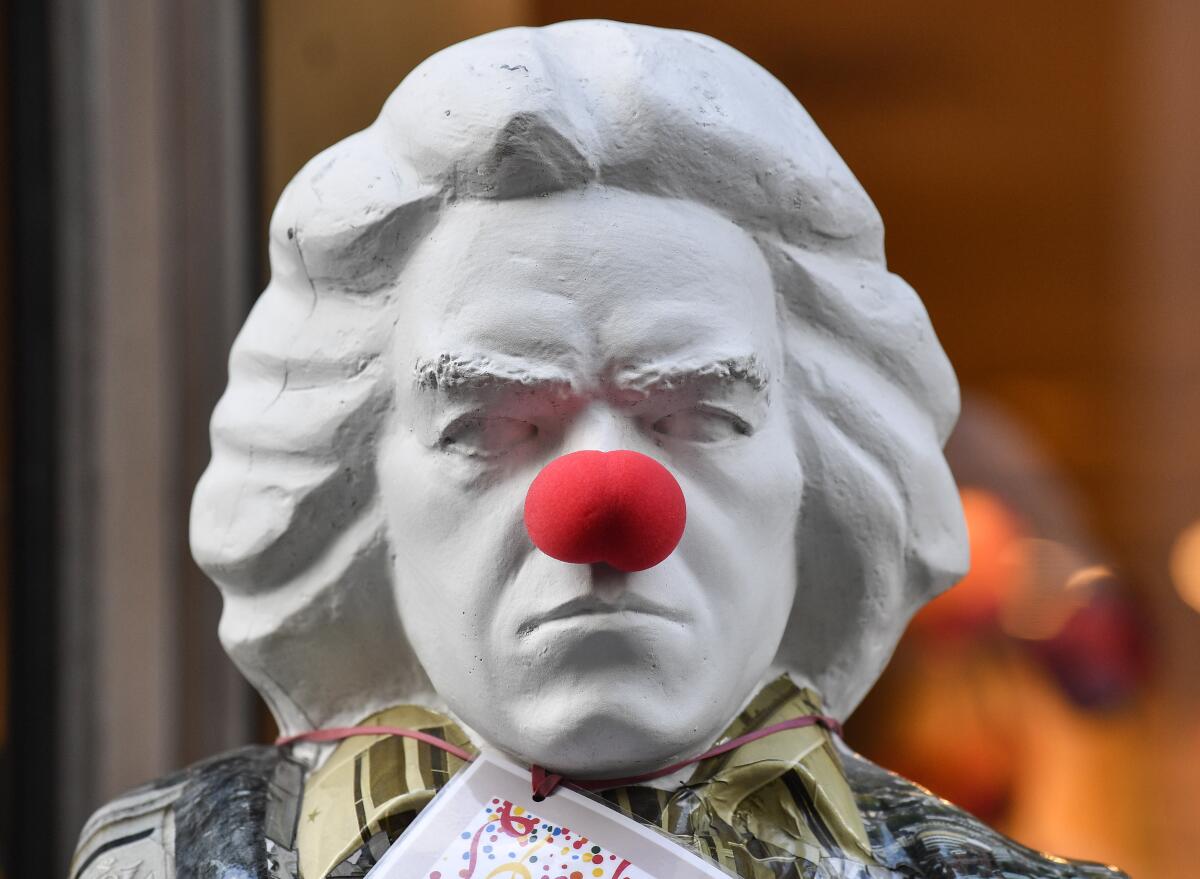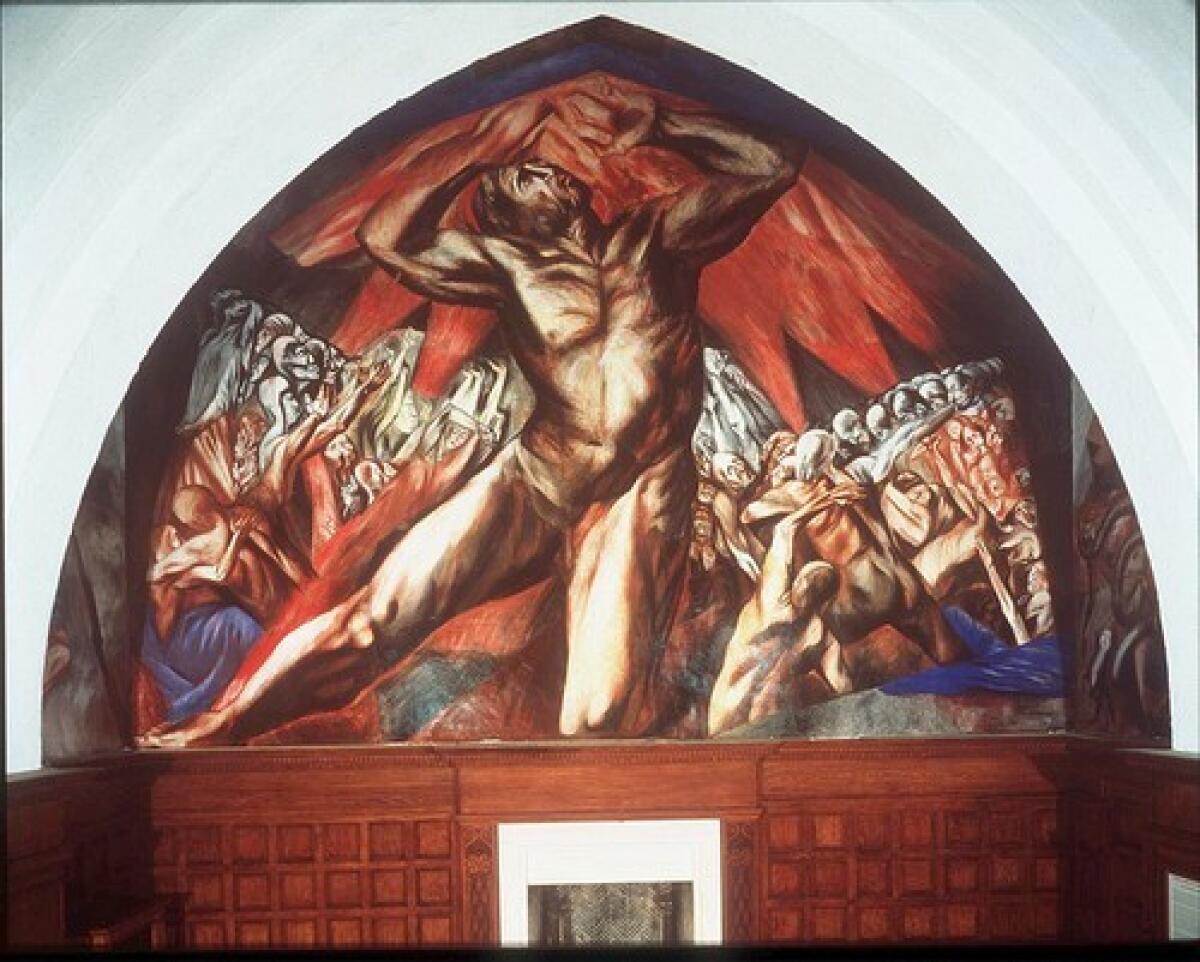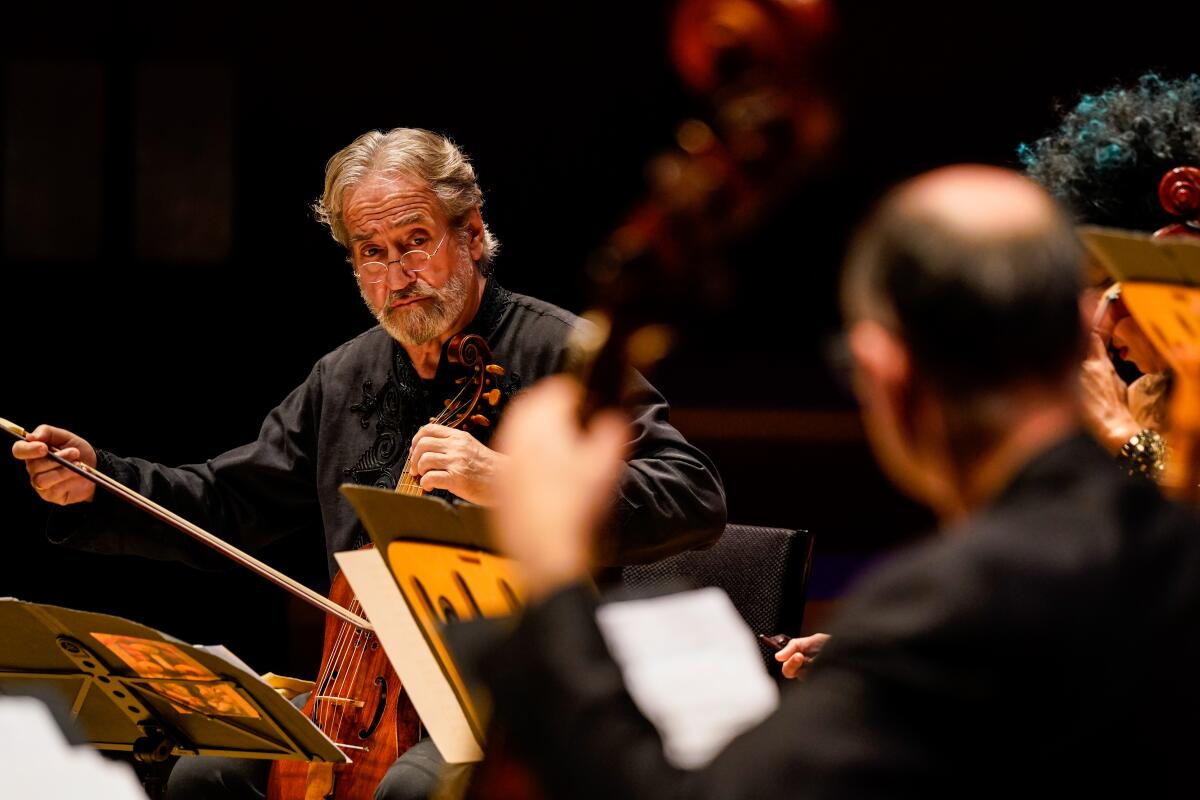Essential Arts: The Beethoven effect and a music critic’s recommendations for what to hear now

Hello, I’m Times music critic Mark Swed, this week giving our irreplaceable Carolina A. Miranda a break before Christmas as we keep arts essential. I’m here just in time to point out that this week our most essential composer, Ludwig van Beethoven — unless you care to call him Louis van Beethoven, as a new German biopic does — marks what would have been his 250th birthday. So Beethoven is where we’ll start.

Music for our times
In his review of the German TV film, Times contributor Robert Abele found it “elegantly tailored” but “never exactly stirring,” which sounds more Louis-like than the Ludwig we all know. I haven’t seen it because I’ve been too busy trying to catch up with all the other things Beethoven. It’s been a full plate. But then, the Beethoven plate is always full. No matter where you are, no matter what you listen to, Beethoven molecules might be in the ether.
It was a late Beethoven string quartet with which I happened to begin my coronavirus-centric “How to Listen” series, because it deals directly with disease and recovery, which is an extraordinary feat for a string quartet. In my discussion about Beethoven’s political significance with William Kinderman, filmed at the Thomas Mann House, the noted UCLA scholar reveals a striking breadth of Beethovian relevance.
Make the most of L.A.
Get our guide to events and happenings in the SoCal arts scene. In your inbox once a week.
You may occasionally receive promotional content from the Los Angeles Times.
The 250th birthday has easily become all about inclusiveness. A big birthday concert televised by the Beethoven Haus in Bonn, Germany, found Irish step dancers stomping, a mime making Beethoven goofy, George Floyd memorialized and the premiere of Quincy Jones’ soulful, joyously jazzy version of the “Ode to Joy.” I’m “stoked and woked,” an exuberant Jones said, calling Beethoven an “inspiration until the end of time.”
Zooming with Hockney
In his 17th century lockdown cottage in Normandy, France, David Hockney imaginatively sketched Beethoven on his iPad (which the Daily Mail in London imaginatively hailed as “scroll over Beethoven”). It perfectly illustrated my own birthday take on the Beethoven effect. Meanwhile, Barbara Isenberg caught up with Hockney via a video call to France and found the 83-year-old artist contentedly scrolling and strolling far beyond Beethoven. Drawing his surroundings daily, he intends to finish the year with 220 pieces that will be exhibited at the Royal Academy of Arts in London next year.

Although he has lost most of his hearing, Hockney retains his love for music. He says he’s thankful that, unlike performing artists, he can stay inside and work and thrive (and, alas, smoke).
A Beethoven-Orozco connection?
What does Beethoven have to do with the Museum of Latin American Art’s controversial auction of works from its permanent collection, a move the chief curator said was to diversify holdings? Not much, on the surface. Times art critic Christopher Knight, who has been closely following the effort, called it a flimsy excuse. “Museum collections are strengthened by the addition of important art, not by its subtractions,” he contends. Reporting by staff writer Deborah Vankin led to commentary by Knight in which he declared the online sale “pretty much a fiasco.”
There is, though, a connection between Mexican murals and Beethoven. In writing about the Whitney Museum of American Art’s revelatory exhibition “Viva Americana: Mexican Muralists Remake American Art, 1925 to 1945,” Carolina A. Miranda reminds us of the importance of the gripping mural “Prometheus,” which José Clemente Orozco painted at Pomona College in 1930. The greatest of Beethoven’s neglected major works is his only ballet, “Creatures of Prometheus.” Esa-Pekka Salonen has revived it with the Philharmonia in London as a marvelous video undertaking that includes fanciful animations by Hillary Leben and commentary by Stephen Fry, and it’s being streamed for free on the orchestra’s website.

If you know me, you’ll know that I interject John Cage into the conversation whenever possible. So, here’s a new fun fact about the Pomona “Prometheus”: In order to get his students more personally invested in the making and meaning of art, the college’s art historian, José Pijoán, had them raise the $300 to commission the mural. One of those students was a sophomore who fashioned himself a writer and, upon watching Orozco work, decided he needed to see the world. This rebellious dropout got Pijoán’s help getting a job working for an architect in Paris. That lasted about 10 minutes — just long enough to convince Cage that music proved a stronger passion.
Enjoying this newsletter? Consider subscribing to the Los Angeles Times
Your support helps us deliver the news that matters most. Become a subscriber.
From Long Beach to D.C.
Following the MoLAA auction, it was Miranda’s turn to question efforts to diversify, or not diversify. Utah Sen. Mike Lee blocked a bill to create the Smithsonian National Museum of the American Latino in Washington, D.C. Lee argued that the museum stood not for diversity but for divisiveness, his term being “balkanization.” Miranda said, “The guy calling out cancel culture proceeded to cancel the museum.” In the process, she noted, Lee also canceled another institution tied to the bill, the National Women’s History Museum.
Armenia artists respond
Miranda also reports that the conflict between Armenia and Azerbaijan has inspired new politically minded art in L.A. and Glendale, home to a large Armenian community. The intention of the new public art, which includes performance and protest songs by L.A. artists of Armenian descent, is to draw attention to the destruction of Armenian culture by Azerbaijani loyalists in the disputed Nagorno-Karabakh region.

I’ll note that L.A.’s community of prominent Armenian musicians, including violinist Movses Pogossian and members of the Los Angeles Philharmonic, have recently released one of the year’s most wondrous recordings, “Con Anima,” a survey of haunting chamber music by Tigran Mansurian, the cult-worthy dean of Armenian music, exquisitely produced on ECM.
What next? As if we know
The pandemic has inspired no end of speculation about the future. Theater critic Charles McNulty reveals some of the unmet potential of virtual theater in his review of magician Helder Guimarães’ “The Future,” which the Geffen Playhouse is presenting via Zoom. Unable to capture the moment as he did in “The Present” in May, Guimarães gives us a future here that comes across as elusive as cappuccino art drawn in the foam.

McNulty was back on Zoom speaking with Donald Trump impersonator J-L Cauvin about his future. The president may not have had such a hot year, what with COVID-19 and the election, but he’s been a boon to humorists. “I’ve had a great year,” Cauvin says, though not without some Twitter spats.
In this week when the Electoral College made Joe Biden’s presidential win official, the award for the best critical prognostication goes to Times television critic Robert Lloyd, who wrote a magnificent column about why he didn’t need to watch the results on election eve and how meaningful that was.
Consolations for the Season of Scrooge
Speaking of the future, it’s impossible to make plans for the week ahead other than to cancel everything, now that we’re in the throes of a terrible COVID-19 surge. No, you can’t go check out the “Prometheus” in Pomona just now. No “Messiah,” no “Nutcracker.” Staying home is the only reasonable option during these holidays, when what we want most from Santa is a vaccine jab.
Last week, listings coordinator Matt Cooper provided suggestions. I’d like to offer a few more. The Canadian experimental opera company Against the Grain Theatre and Toronto Symphony have filmed a version of an all-Canada “Messiah.” Beethoven doesn’t have a monopoly on inclusivity. This is Handel in Arabic (“He is despised” sung in a mosque), Dene, French, Inuktitut, Southern Tutchone and, yes, there’s still some English. The singers are phenomenal, and so is the filming from First Nations northern lands to Toronto’s Graffiti Alley. This deserves to become a holiday classic, and it can be seen for a month on the Against the Grain website.
A too-seldom-heard alternative to “The Messiah” is Bach’s “Christmas Oratorio.” Couldn’t you use a couple of hours of uplift? A new recording conducted by Jordi Savall with his usual Catalan forces may be slightly less jubilant than most (who isn’t these days?), but it has a spiritual glow that is exactly what we need. Here is a great musician who really can read the future: The recording was made in Spain at the end of 2019.

More culture to catch
Staff writer Makeda Easter writes about a compelling virtual art exhibition aimed at humanizing the incarcerated.
If you haven’t yet seen Viola Davis and the late Chadwick Boseman in the Netflix version of “Ma Rainey’s Black Bottom,” stream it now and then read staff writer Ashley Lee as she digs into the ending.
Reviews of Center Theatre Group’s “Elephant Room: Dust From the Stars” and “Estella Scrooge” imply some pandemic amusements, but don’t count on “Museum Town,” a superficial new documentary about MASS MoCA, or on the Academy Museum of Motion Pictures, whose opening date initially had been set for this week. On Friday the Academy Museum, citing rising COVID-19 infection rates in L.A. County, postponed the opening again, this time to Sept. 30.
And last but not least ...
A New Year’s suggestion: Go to the website of the Komische Oper in Berlin and see what operetta irreverence director Barrie Kosky is up to. Kosky is the world’s master of chorus lines, so expect to be mouthing OMGs after each chorus line proves more outrageous than the last. Check out what ever is on. It’s the best opera entertainment out there.
Essential Arts will be on holiday next weekend, but the newsletter will be back with Carolina A. Miranda in the writer’s seat Jan. 2.
Coronavirus may have silenced our symphony halls, taking away the essential communal experience of the concert as we know it, but The Times invites you to join us on a different kind of shared journey: a new series on listening.
The biggest entertainment stories
Get our big stories about Hollywood, film, television, music, arts, culture and more right in your inbox as soon as they publish.
You may occasionally receive promotional content from the Los Angeles Times.





